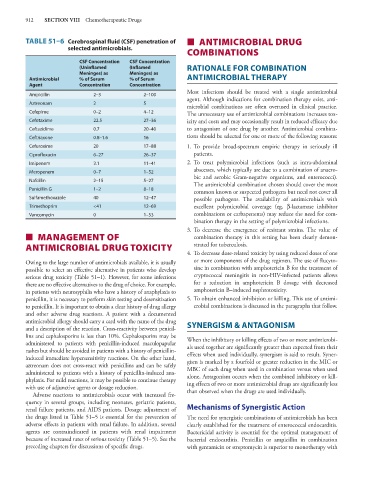Page 926 - Basic _ Clinical Pharmacology ( PDFDrive )
P. 926
912 SECTION VIII Chemotherapeutic Drugs
TABLE 51–6 Cerebrospinal fluid (CSF) penetration of ■ ANTIMICROBIAL DRUG
selected antimicrobials.
COMBINATIONS
CSF Concentration CSF Concentration
(Uninflamed (Inflamed RATIONALE FOR COMBINATION
Meninges) as Meninges) as
Antimicrobial % of Serum % of Serum ANTIMICROBIAL THERAPY
Agent Concentration Concentration
Most infections should be treated with a single antimicrobial
Ampicillin 2–3 2–100
agent. Although indications for combination therapy exist, anti-
Aztreonam 2 5
microbial combinations are often overused in clinical practice.
Cefepime 0–2 4–12 The unnecessary use of antimicrobial combinations increases tox-
Cefotaxime 22.5 27–36 icity and costs and may occasionally result in reduced efficacy due
Ceftazidime 0.7 20–40 to antagonism of one drug by another. Antimicrobial combina-
Ceftriaxone 0.8–1.6 16 tions should be selected for one or more of the following reasons:
Cefuroxime 20 17–88 1. To provide broad-spectrum empiric therapy in seriously ill
Ciprofloxacin 6–27 26–37 patients.
Imipenem 3.1 11–41 2. To treat polymicrobial infections (such as intra-abdominal
Meropenem 0–7 1–52 abscesses, which typically are due to a combination of anaero-
bic and aerobic Gram-negative organisms, and enterococci).
Nafcillin 2–15 5–27
The antimicrobial combination chosen should cover the most
Penicillin G 1–2 8–18
common known or suspected pathogens but need not cover all
Sulfamethoxazole 40 12–47 possible pathogens. The availability of antimicrobials with
Trimethoprim <41 12–69 excellent polymicrobial coverage (eg, β-lactamase inhibitor
Vancomycin 0 1–53 combinations or carbapenems) may reduce the need for com-
bination therapy in the setting of polymicrobial infections.
3. To decrease the emergence of resistant strains. The value of
■ MANAGEMENT OF combination therapy in this setting has been clearly demon-
ANTIMICROBIAL DRUG TOXICITY strated for tuberculosis.
4. To decrease dose-related toxicity by using reduced doses of one
Owing to the large number of antimicrobials available, it is usually or more components of the drug regimen. The use of flucyto-
possible to select an effective alternative in patients who develop sine in combination with amphotericin B for the treatment of
serious drug toxicity (Table 51–1). However, for some infections cryptococcal meningitis in non-HIV-infected patients allows
there are no effective alternatives to the drug of choice. For example, for a reduction in amphotericin B dosage with decreased
in patients with neurosyphilis who have a history of anaphylaxis to amphotericin B–induced nephrotoxicity.
penicillin, it is necessary to perform skin testing and desensitization 5. To obtain enhanced inhibition or killing. This use of antimi-
to penicillin. It is important to obtain a clear history of drug allergy crobial combinations is discussed in the paragraphs that follow.
and other adverse drug reactions. A patient with a documented
antimicrobial allergy should carry a card with the name of the drug SYNERGISM & ANTAGONISM
and a description of the reaction. Cross-reactivity between penicil-
lins and cephalosporins is less than 10%. Cephalosporins may be When the inhibitory or killing effects of two or more antimicrobi-
administered to patients with penicillin-induced maculopapular als used together are significantly greater than expected from their
rashes but should be avoided in patients with a history of penicillin- effects when used individually, synergism is said to result. Syner-
induced immediate hypersensitivity reactions. On the other hand, gism is marked by a fourfold or greater reduction in the MIC or
aztreonam does not cross-react with penicillins and can be safely MBC of each drug when used in combination versus when used
administered to patients with a history of penicillin-induced ana- alone. Antagonism occurs when the combined inhibitory or kill-
phylaxis. For mild reactions, it may be possible to continue therapy ing effects of two or more antimicrobial drugs are significantly less
with use of adjunctive agents or dosage reduction. than observed when the drugs are used individually.
Adverse reactions to antimicrobials occur with increased fre-
quency in several groups, including neonates, geriatric patients,
renal failure patients, and AIDS patients. Dosage adjustment of Mechanisms of Synergistic Action
the drugs listed in Table 51–5 is essential for the prevention of The need for synergistic combinations of antimicrobials has been
adverse effects in patients with renal failure. In addition, several clearly established for the treatment of enterococcal endocarditis.
agents are contraindicated in patients with renal impairment Bactericidal activity is essential for the optimal management of
because of increased rates of serious toxicity (Table 51–5). See the bacterial endocarditis. Penicillin or ampicillin in combination
preceding chapters for discussions of specific drugs. with gentamicin or streptomycin is superior to monotherapy with

